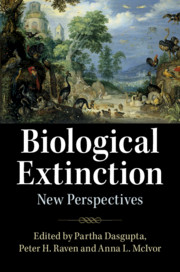Book contents
- Biological Extinction: New Perspectives
- Biological Extinction: New Perspectives
- Copyright page
- Dedication
- Contents
- Figures
- Tables
- Contributors
- Preface
- Acknowledgements
- Introduction
- Prologue
- 1 Extinction in Deep Time
- 2 Biodiversity and Global Change
- 3 The State of the World’s Biodiversity
- 4 Extinction Threats to Life in the Ocean and Opportunities for Their Amelioration
- 5 Out of the Soil
- 6 The Green Revolution and Crop Biodiversity
- 7 Population
- 8 Game Over?
- 9 Why We’re in the Sixth Great Extinction and What It Means to Humanity
- 10 The Consequences of Biodiversity Loss for Human Well-Being
- 11 Terra Incognita
- 12 How Do We Stem Biodiversity Loss?
- 13 Can Smart Villages Help to Stem Biodiversity Loss?
- 14 The New Design Condition
- Index
- Plate Section (PDF Only)
- References
1 - Extinction in Deep Time
Lessons from the Past?
Published online by Cambridge University Press: 19 August 2019
- Biological Extinction: New Perspectives
- Biological Extinction: New Perspectives
- Copyright page
- Dedication
- Contents
- Figures
- Tables
- Contributors
- Preface
- Acknowledgements
- Introduction
- Prologue
- 1 Extinction in Deep Time
- 2 Biodiversity and Global Change
- 3 The State of the World’s Biodiversity
- 4 Extinction Threats to Life in the Ocean and Opportunities for Their Amelioration
- 5 Out of the Soil
- 6 The Green Revolution and Crop Biodiversity
- 7 Population
- 8 Game Over?
- 9 Why We’re in the Sixth Great Extinction and What It Means to Humanity
- 10 The Consequences of Biodiversity Loss for Human Well-Being
- 11 Terra Incognita
- 12 How Do We Stem Biodiversity Loss?
- 13 Can Smart Villages Help to Stem Biodiversity Loss?
- 14 The New Design Condition
- Index
- Plate Section (PDF Only)
- References
Summary
The rocks of the world contain a record of more than 3.5 billion years of change to the living world. As new evidence of past life emerges, increasing rigour is brought to the data that tell of species abundance, distribution and relationships through time. In addition, refinements of the stratigraphic record and new insights into past environments illuminate the physical factors that affect the structure and function of ancient ecosystems, particularly how they respond to climate change over time. For these reasons, palaeontological and geological data can be brought to bear on issues central to understanding biodiversity – the rates and patterns of species loss, mechanisms that drive diversity change and features that make some species and times susceptible to extinction. Moreover, the rock and fossil record can inform an understanding of ecosystem recovery after extinctions, revealing how diversity can rebuild after major catastrophes. While ancient fossil records can reveal the physical and biotic factors that underlie extinction, more recent ones are particularly informative. In the right settings, high-resolution recent fossil records can reveal how ecological communities looked and functioned before our own species’ arrival.
- Type
- Chapter
- Information
- Biological ExtinctionNew Perspectives, pp. 22 - 33Publisher: Cambridge University PressPrint publication year: 2019
References
- 1
- Cited by



